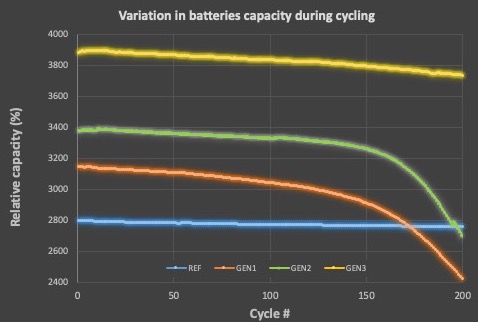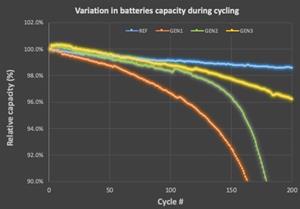Silicon-Based Anode Batteries Achieve 3,734 mAh with 96% Capacity Retention after 200 Cycles, Surpassing Commercial Alternatives by 66%
- 18650 batteries with GEN3 silicon-based materials continue to deliver 3,734 mAh of capacity after 200 cycles [1], surpassing the MuRata high-performance US18650VTC6 battery by 25% compared to its advertised starting capacity of 3,000 mAh, and by 66% compared to its capacity at 200 cycles [2]
MONTREAL, Sept. 18, 2024 (GLOBE NEWSWIRE) -- HPQ Silicon Inc. (“HPQ” or the “Company”) (TSX-V: HPQ, OTCQB: HPQFF, FRA: O08), a technology company specializing in green engineering of silica and silicon-based materials, is pleased to update shareholders on the latest battery milestones achieved by its France-based affiliate, NOVACIUM SAS (“Novacium”).
Recent charge-discharge tests at the 200-cycle mark for Lithium-ion 18650 batteries, made with a blend of graphite and Novacium’s GEN3 silicon-based anode material, revealed a 36% capacity improvement with only 2% degradation compared to graphite benchmarks. The remaining capacity of 3,734 mAh exceeds the starting capacities of leading 18650 battery models, which range from 3,000 mAh (+25%) [2] to 3,450 mAh (+8%) [3]. After 200 cycles, the GEN3 battery outperforms top models by 25% [3] to 66% [2].
“I’m thrilled with the overall result that our GEN3 silicon-based anode material consistently outperforms commercial benchmarks under very rigorous testing protocols [4],” said Dr. Jed Kraiem, COO of Novacium. “The observed 36% capacity improvement and minimal degradation over 200 cycles underscore the material's potential to enhance energy density and extend the operational lifespan of lithium-ion batteries, positioning it as a breakthrough in battery technology.”
Enhancing Battery Performance with Silicon-Based Anode Materials

Graph 1) Average capacity, in milliampere-hours (mAh), of 100% graphite, GEN1, GEN2 & GEN3 batteries over 200 cycle testing [1] (the blue, orange, green and yellow lines).
Graph 1 illustrates the battery capacity (in mAh) of 18650 batteries made with Novacium's GEN3 (yellow line), GEN2 (green line), GEN1 (orange line), and a 100% graphite benchmark (blue line) over 200 cycles. At the 200-cycle mark, GEN3 batteries maintain an average capacity of 3,734 mAh, outperforming the graphite benchmark at 2,756 mAh. In contrast, both GEN2 at 2,694 mAh and GEN1 at 2,421 mAh perform worse than the graphite benchmark. This data indicates that GEN3 silicon-based batteries offer approximately 36% more capacity than the graphite benchmark, 54% more than GEN1, and 39% more than GEN2 after 200 cycles.
Silicon-Based Anode Materials with graphite-like degradation curb at 200 cycles

Graph 2) The blue line shows the relative capacity of 100% graphite batteries, the orange line the relative capacity of GEN1 batteries, the green line the relative capacity of GEN 2 batteries and the yellow line shows the relative capacity of GEN 3 batteries over 200 cycles [1]
Graph 2 demonstrates the minimal performance degradation for GEN3 advanced silicon material over 200 cycles, with a capacity retention of 96.2% compared to 98.6% for the graphite benchmark— a difference of 2.4%. Specifically, the absolute capacity of the GEN3 batteries (yellow line) decreased from 3,883 mAh to 3,734 mAh. In comparison, GEN2 batteries (green line) retained 79.6% of its capacity, dropping from 3,370 mAh to 2,694 mAh, while GEN1 batteries (orange line) retained only 77.0% of its capacity, decreasing from 3,145 mAh to 2,421 mAh. The graphite benchmark (blue line) showed a slight decline from 2,780 mAh to 2,756 mAh, retaining 98.6% capacity.
Graph 2 further illustrates that between 150 and 200 cycles, batteries using the graphite benchmark experienced a 0.2% degradation in capacity (from 98.8% to 98.6%), while batteries made with Novacium GEN3 materials showed a 1.6 % degradation (from 97.8% to 96.2%), a result that is comparable to graphite degradation. By comparison, batteries made with Novacium GEN2 materials experienced a 16.7% degradation (from 96.3% to 79.6%), while those made with GEN1 materials showed a 15 % degradation (from 92.5 % to 77.0%).
“I am also very excited by the fact that our partially optimized GEN3 material is able to reduce the observed degradation past 170 cycles compared to our GEN1 and GEN2 materials,” added Dr Kraiem.
“These results at 200 cycles place our silicon-based anode material technology in an enviable position, demonstrating real-world potential to significantly improve the performance of 18650 and 21700 batteries, a market expected to reach US $25 billion by 2026 [5],” said Bernard Tourillon, President and CEO of HPQ Silicon Inc. and NOVACIUM SAS. “This could position HPQ and NOVACIUM as key players in delivering next-generation energy solutions that meet both performance and sustainability targets for the industry.”
REFERENCE SOURCES
| [1] | Novacium technical team analysis of the data from the ongoing charging and discharging cycle tests conducted at a world-leading university, the name of which is kept confidential for competitive reasons. |
| [2] | Link to the source of the information onMuRataManufacturing high-performance US18650VTC6 |
| [3] | Link to the source of the information onNCR18650G-datasheet-specifications-Panasonic, |
| [4] | Cycling parameters from: Ratnakumar Bugga et al. “Performance of Commercial High Energy and High Power Li-Ion Cells in Jovian Missions Encountering High Radiation Environments”, NASA Battery Workshop November 19-21, 2019. |
| [5] | According to Business Research insights, the global 18650 and 21700 Battery Market size was US$ 12.6 billion in 2022 and it is expected to reach US$ 25.4 billion by 2028, exhibiting a CAGR of 12.4% during the forecast period. Link to source. |
| [6] | Link to the source of the information onSamsung INR18650-35E Battery capacity graph. |
About NOVACIUM SAS
Novacium is an HPQ - affiliated company that started in Q3 2022. This green technology startup is based in Lyon, France and is a partnership with HPQ and three of France’s leading research engineers, Dr. Jed KRAIEM PhD, Novacium's Chief Operating Officer (“COO”), Dr. Oleksiy NICHIPORUK PhD, Novacium's Chief Technical Officer (“CTO”), and Dr. Julien DEGOULANGE PhD, Novacium’s Chief Innovation Officer (“CIO”). Novacium is a new Research and Development company which allows researchers to develop their own technology in high-added-value fields connected to renewable energy and allows HPQ Silicon Inc. a Canadian company, to expand the depth and reach of its technical team to help develop its silicon and new renewable energy projects.
About HPQ Silicon
HPQ Silicon Inc. (TSX-V: HPQ) is a Quebec-based TSX Venture Exchange Tier 1 Industrial Issuer.
HPQ is developing, with the support of world-class technology partners PyroGenesis Canada Inc. and NOVACIUM SAS, new green processes crucial to make the critical materials needed to reach net zero emissions.
HPQ activities are centred around the following four (4) pillars:
| 1) | Becoming a green low-cost (Capex and Opex) manufacturer of Fumed Silica using the FUMED SILICA REACTOR, a proprietary technology owned by HPQ Silica Polvere Inc being developed for HSPI by PyroGenesis. |
| 2) | Becoming a producer of silicon-based anode materials for battery applications with the assistance of NOVACIUM SAS. |
| 3) | HPQ SILICON affiliate NOVACIUM SAS is developing a low carbon, chemical based on demand and high-pressure autonomous hydrogen production system. |
| 4) | Becoming a zero CO2 low-cost (Capex and Opex) producer of High Purity Silicon (2N+ to 4N) using our PUREVAPTM “Quartz Reduction Reactors” (QRR), a proprietary technology owned by HPQ being developed for HPQ by PyroGenesis. |
For more information, please visit HPQ Silicon web site.
Disclaimers:
This press release contains certain forward-looking statements, including, without limitation, statements containing the words "may", "plan", "will", "estimate", "continue", "anticipate", "intend", "expect", "in the process" and other similar expressions which constitute "forward-looking information" within the meaning of applicable securities laws. Forward-looking statements reflect the Company's current expectation and assumptions and are subject to a number of risks and uncertainties that could cause actual results to differ materially from those anticipated. These forward-looking statements involve risks and uncertainties including, but not limited to, our expectations regarding the acceptance of our products by the market, our strategy to develop new products and enhance the capabilities of existing products, our strategy with respect to research and development, the impact of competitive products and pricing, new product development, and uncertainties related to the regulatory approval process. Such statements reflect the current views of the Company with respect to future events and are subject to certain risks and uncertainties and other risks detailed from time-to-time in the Company's ongoing filings with the security’s regulatory authorities, which filings can be found at www.sedar.com. Actual results, events, and performance may differ materially. Readers are cautioned not to place undue reliance on these forward-looking statements. The Company undertakes no obligation to publicly update or revise any forward-looking statements either as a result of new information, future events or otherwise, except as required by applicable securities laws.
Neither the TSX Venture Exchange nor its Regulation Services Provider (as that term is defined in the policies of the TSX Venture Exchange) accepts responsibility for the adequacy or accuracy of this release.
This News Release is available on the company's CEO Verified Discussion Forum, a moderated social media platform that enables civilized discussion and Q&A between Management and Shareholders.
Source: HPQ Silicon Inc.
For further information contact:
Bernard J. Tourillon, Chairman, President, and CEO Tel +1 (514) 846-3271
Patrick Levasseur, Director Tel: +1 (514) 262-9239
Email: Info@hpqsilicon.com
Photos accompanying this announcement are available at:
https://www.globenewswire.com/NewsRoom/AttachmentNg/0bd7cccb-951e-46a9-b519-c3e226a8d6f0
https://www.globenewswire.com/NewsRoom/AttachmentNg/fbb14fcb-12d7-4775-baff-d58825745c82


